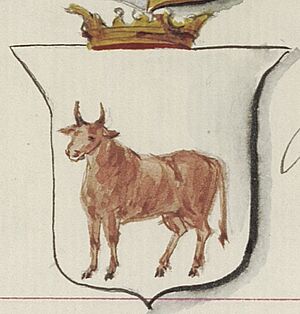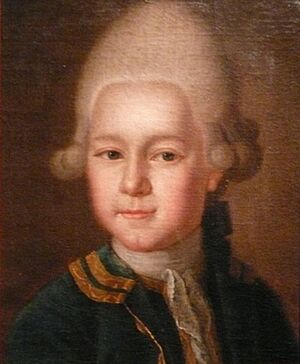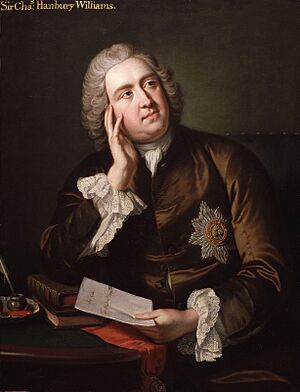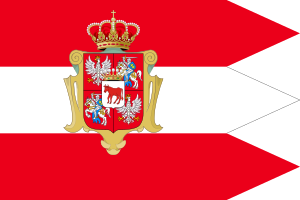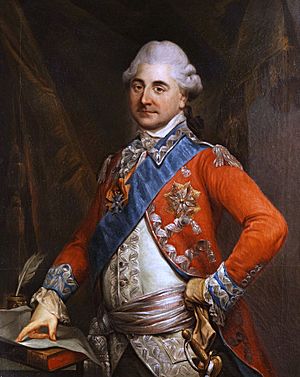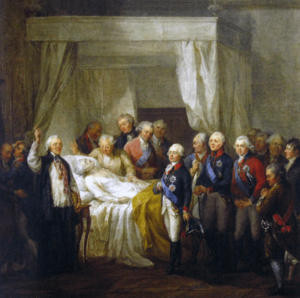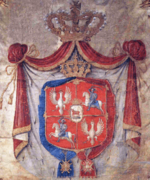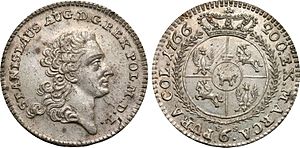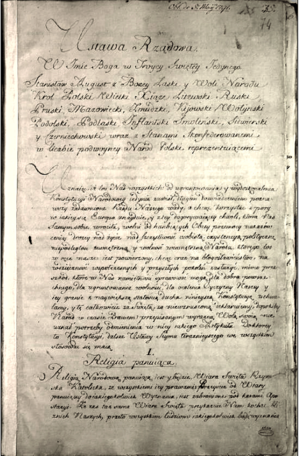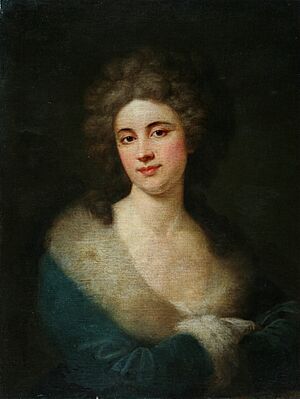Stanisław August Poniatowski facts for kids
Quick facts for kids Stanisław II August |
|||||
|---|---|---|---|---|---|
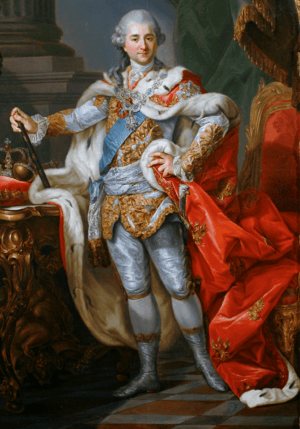
Stanisław August in coronation robes
|
|||||
| King of Poland Grand Duke of Lithuania |
|||||
| Reign | 7 September 1764 – 25 November 1795 | ||||
| Coronation | 25 November 1764 St. John's Archcathedral, Warsaw |
||||
| Predecessor | Augustus III | ||||
| Successor | monarchy suppressed (Partitions of Poland) | ||||
| Born | 17 January 1732 Wołczyn, Polish–Lithuanian Commonwealth |
||||
| Died | 12 February 1798 (aged 66) Saint Petersburg, Russian Empire |
||||
| Burial | St. John's Archcathedral, Warsaw | ||||
| Issue Details... |
illegitimate | ||||
|
|||||
| House | Poniatowski | ||||
| Father | Stanisław Poniatowski | ||||
| Mother | Konstancja Czartoryska | ||||
| Religion | Roman Catholicism | ||||
| Signature | |||||
Stanisław II August (born Stanisław Antoni Poniatowski; 17 January 1732 – 12 February 1798) was the last King of Poland and Grand Duke of Lithuania. He ruled the Polish–Lithuanian Commonwealth from 1764 to 1795.
Stanisław was born into a rich Polish noble family. In 1755, at age 22, he became a diplomat at the Russian court in Saint Petersburg. There, he became close with the future empress Catherine the Great. With her help, he was chosen as King of Poland in September 1764. This happened after the death of Augustus III of Poland.
King Stanisław II August tried to make the large but struggling Commonwealth stronger. But his efforts faced problems from nearby countries like Prussia, Russia, and Austria. These countries wanted Poland to stay weak. Inside Poland, some conservative nobles also opposed his changes. They felt the reforms threatened their old freedoms.
A big challenge in his early rule was the War of the Bar Confederation (1768–1772). This war led to the First Partition of Poland in 1772. Later, during his reign, the Polish Parliament (1788–1792) made important reforms. These included the famous Constitution of 3 May 1791.
However, these reforms were overturned by the Targowica Confederation in 1792. This led to the Polish–Russian War of 1792. Soon after, the Second Partition of Poland happened in 1793. The Kościuszko Uprising in 1794 and the Third Partition of Poland in 1795 marked the end of the Commonwealth. Stanisław II August lost all his power and gave up his throne in November 1795. He spent his last years living in Saint Petersburg as a captive.
Stanisław II August is a debated figure in Polish history. Some criticize him for not stopping the Partitions of Poland, which destroyed the Polish state. Others remember him as a great supporter of arts and sciences. He helped create the Commission of National Education, the first institution of its kind. He also supported the Great Sejm and the Constitution of 3 May 1791. Many historians believe he was a skilled leader, given the difficult times he lived in.
Contents
Early Life and Education
Stanisław Antoni Poniatowski was born on January 17, 1732. His birthplace was Wołczyn, which was then part of the Polish–Lithuanian Commonwealth. He was one of eight children. His parents were Princess Konstancja Czartoryska and Count Stanisław Poniatowski. His father was a high-ranking official in Kraków.
He spent his early childhood in Gdańsk. Once, as a toddler, he was briefly taken by force. This happened because his father supported King Augustus III of Poland. He was soon returned to his parents. Later, his family moved to Warsaw.
Stanisław was first taught by his mother. Then, he had private teachers, including the Russian ambassador Herman Karl von Keyserling. As a teenager, he loved reading books. This love for books stayed with him his whole life. In 1748, he went on his first trip abroad. He traveled with the Russian army into the Rhineland. This trip allowed him to visit cities like Aachen and explore the Netherlands.
Starting a Political Career
In 1749, Stanisław started working for Michał Fryderyk Czartoryski. He was the Deputy Chancellor of Lithuania. In 1750, he met a British diplomat, Charles Hanbury Williams, in Berlin. Williams became his mentor and friend. Stanisław was elected to the Treasury Tribunal in Radom in 1751. He served there as a commissioner.
He traveled often, visiting Vienna, Hungary, Paris, and Britain. In Britain, he became friends with Charles Yorke, who later became a very important judge. Stanisław's rise in politics was largely due to his family. He was connected to the powerful Czartoryski family and their political group, known as the Familia.
The Familia sent him to Saint Petersburg in 1755. He worked for Williams, who was then the British ambassador to Russia. In Saint Petersburg, Williams introduced Stanisław to Catherine Alexeievna. She was 26 and would later become Empress Catherine the Great. Stanisław and Catherine formed a close relationship. He likely saw this as a chance to boost his career.
Stanisław had to leave St. Petersburg in July 1756 due to court politics. But he returned in January 1757 as an ambassador for Saxony. He left the Russian capital for good on August 14, 1758. He continued to be involved with the Familia. He supported policies that favored Russia and opposed Prussia in Poland.
In 1762, Catherine became the Russian Empress. She sent him letters supporting his claim to the Polish throne. But she asked him to stay away from St. Petersburg. Stanisław hoped Catherine would marry him, an idea some international observers thought possible. He also joined a failed plan by the Familia to overthrow King Augustus III of Poland. However, in August 1763, Catherine said she would not support a coup while King Augustus was alive.
Becoming King of Poland
Hopes for Reform
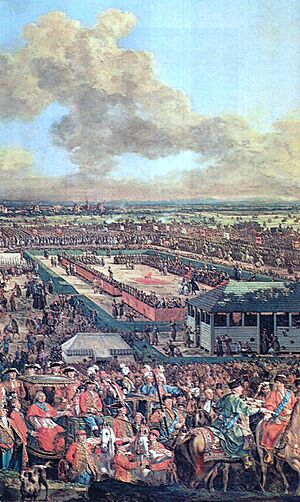
When Poland's King Augustus III died in October 1763, the search for a new king began. Catherine supported Stanisław Poniatowski. Russia spent a lot of money to help him get elected. There were some small military clashes between his supporters and opponents. Finally, the Russian army was placed near the election site.
On September 7, 1764, 32-year-old Stanisław Poniatowski was elected king. He received 5,584 votes. He took his oath on November 13. His official coronation happened in Warsaw on November 25. His "uncles" in the Familia had wanted another relative to be king. But Stanisław was chosen.
King Stanisław August, as he now called himself, started his rule with mixed support. Mostly, smaller nobles favored him. In his first years, he tried to make many reforms. He started the Knights School. He also began to create a diplomatic service. This service would have permanent representatives across Europe and in the Ottoman Empire.
On May 7, 1765, Stanisław established the Order of Saint Stanislaus. This was Poland's second highest honor. It rewarded Poles and others for great service to the King. He also tried to fix the government with the Familia. They aimed to reduce the power of military commanders and treasurers. Instead, these roles would be given to commissions chosen by the Parliament and answerable to the King. Stanisław called this time the "years of hope."
The Familia wanted to increase its own power. They were unhappy with Stanisław's friendly approach to his former opponents. This uneasy partnership between Stanisław and the Familia lasted for about ten years. One disagreement was about the rights of religious minorities in Poland. Stanisław supported religious tolerance, but the Familia did not. Russia used this disagreement to interfere in Poland's politics. Catherine did not want Stanisław's reforms to succeed. She had supported him to keep Poland under Russian control. His efforts to reform the government were a threat to this.
Challenges and the First Partition
Things became very difficult in 1766. During the Parliament meeting that October, Stanisław tried to pass a big reform. He wanted to limit the damaging liberum veto rule. This rule allowed any single noble to stop a law. But conservatives, supported by Prussian and Russian ambassadors, opposed him. They threatened war if the reform passed.
Nobles who disagreed with the King formed the Radom Confederation. Stanisław's reforms failed. The Russian ambassador, Nicholas Repnin, promised to protect the traditional freedoms of Polish nobles. Other groups then formed the Bar Confederation. This group was against the conservatives, Stanisław, and the Russians.
Stanisław tried to find allies in Western Europe, but failed. He and the Familia had to rely more on Russia. Russia treated Poland like a controlled state. In the War of the Bar Confederation (1768–1772), Stanisław supported the Russian army against the Bar Confederation. In 1770, the Bar Confederation declared him no longer king. The next year, he was briefly kidnapped by them but escaped.
Because Poland was so weak, Austria, Russia, and Prussia decided to take parts of its land. This decision was made without asking Stanisław or any Polish leaders.
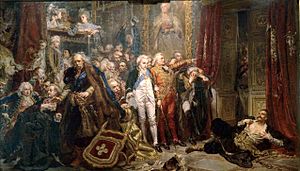
Stanisław protested against the First Partition of Poland in 1772. But he could do nothing to stop it. He thought about giving up his throne, but decided not to. During the Partition Sejm (Parliament) of 1773–1775, Russian troops occupied Warsaw. This forced the Parliament to agree to the "partition treaty."
At the same time, some other reforms were passed. The Cardinal Laws were confirmed and guaranteed by the partitioning powers. The King's power was limited. He could no longer give out titles or military promotions. The Parliament also created two important groups: the Permanent Council and the Commission of National Education. The Permanent Council was a government body that ran all the time. The partitioning powers wanted it to be easier to control than the unruly Parliaments. It did stay under Russian influence. Still, it was an improvement for Poland's government.
After the Partition Sejm, a group of conservatives rose up. They opposed the Permanent Council, seeing it as a threat to their freedoms. This group was supported by the Czartoryski family. But Stanisław was not with them. He became good at making the Council follow his wishes. This led to new groups in Polish politics: those against the King and those for him. The King's supporters were mostly people who owed him favors. They planned to build their careers by serving him. Few knew about his secret plans for more reforms.
Stanisław won a political victory in the Parliament of 1776. This further strengthened the council. Chancellor Andrzej Zamoyski was asked to write down Polish laws. This project became known as the Zamoyski Code. Russia supported some, but not all, of the 1776 reforms. To stop Stanisław from becoming too powerful, Russia supported the opposition in the 1778 Parliament. This ended Stanisław's reforms. He no longer had enough support to carry them out.
The Great Sejm and the Constitution
In the 1780s, Catherine seemed to favor Stanisław a little more than his opponents. But she did not support any of his big reform plans. Stanisław tried many times to make the Parliaments immune to the liberum veto. This would have allowed laws to pass more easily. But he failed. So, even with a majority in Parliament, he could not pass small reforms. The Zamoyski Code was rejected in 1780. Attacks on the King dominated the Parliaments of 1782 and 1786.
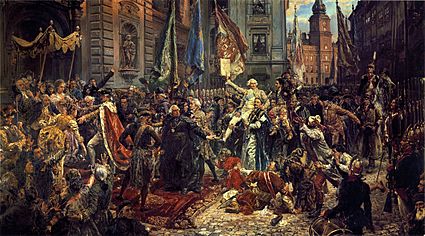
Reforms became possible again in the late 1780s. Russia and Austria were fighting wars against the Ottoman Empire. Stanisław tried to get Poland to join the Austro-Russian alliance. He saw a war with the Ottomans as a chance to make Poland stronger. Catherine allowed the next Parliament to be called. She thought a limited military alliance with Poland against the Ottomans might be useful.
The Polish-Russian alliance did not happen. But in the Four-Year Parliament of 1788–92, known as the Great Sejm, Stanisław joined the reformers. These reformers were part of the Patriotic Party. Together, they wrote the Constitution of 3 May 1791. This Constitution brought many big changes.
Historians say the Constitution gave Poland a "constitutional monarchy." This was similar to the British system at the time. Stanisław himself said it was based on the English and American Constitutions. He said it avoided their faults and was adapted to Poland's needs. The Constitution of 3 May was still being worked on. There were plans for new civil and criminal laws. Stanisław also planned to improve the lives of Polish Jews.
In foreign policy, Poland turned to Prussia for help. This led to the Polish–Prussian alliance, which did not end up being helpful. Stanisław did not fully support this shift to Prussia. But he agreed to the Parliament's decision. The passing of the Constitution worried Prussia. A strong Poland might demand back lands Prussia took in the First Partition. Catherine was furious about the Constitution. It threatened Russia's control over Poland.
War and the Fall of Poland
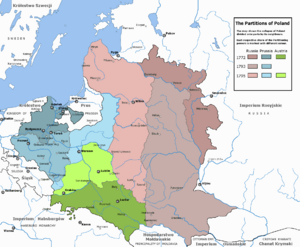
Soon after, conservative Polish nobles formed the Confederation of Targowica. They wanted to overthrow the Constitution. They saw it as a threat to their old freedoms. These nobles allied with Russia's Catherine the Great. The Russian army entered Poland. This started the Polish–Russian War of 1792, also called the War in Defense of the Constitution.
The Parliament voted to increase the Polish Army to 100,000 men. But there wasn't enough time or money. Stanisław and the reformers could only gather about 37,000 soldiers. Many of them were new recruits. This army, led by the King's nephew Józef Poniatowski and Tadeusz Kościuszko, fought well. They sometimes defeated the Russians or fought them to a draw. After a victory at the Battle of Zieleńce, the King created a new award, the Order of Virtuti Militari. This honored Polish soldiers for bravery.
Despite Poland's requests, Prussia did not help. The Russian army was too large, and defeat seemed certain. Stanisław's attempts to talk with Russia failed. In July 1792, Warsaw was in danger of being attacked by the Russians. The King believed that surrendering was the only choice. He received promises from the Russian ambassador that no land would be taken. A group of ministers voted to surrender.
On July 24, 1792, Stanisław joined the Targowica Confederation. The Polish Army fell apart. Many reform leaders left the country. They hoped Stanisław could still make a deal with the Russians. But Stanisław could not save Poland. He and the reformers lost much of their power. The Targowica Confederates also did not win. To their surprise, the Second Partition of Poland happened. The Grodno Sejm (Parliament) took place. On November 23, 1793, it canceled all the laws of the Great Sejm, including the Constitution. Facing his powerlessness, Stanisław again thought about giving up his throne. He tried to save what reforms he could.
Later Life and Death
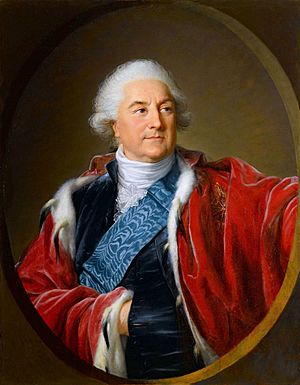
Stanisław's plans were ruined by the Kościuszko Uprising. The King did not start it, but he supported it once it began. Its defeat meant the end of the Commonwealth. Stanisław tried to govern for a short time after the Uprising fell. But on December 2, 1794, Catherine demanded he leave Warsaw. He left on January 7, 1795, under Russian guard. He settled in Grodno.
On October 24, 1795, the final Third Partition of Poland was signed. One month later, on November 25, Stanisław signed his abdication. His sister and niece were reportedly threatened with losing their property. They feared his refusal would lead to their ruin. This may have helped persuade him to sign.
Catherine the Great died on November 17, 1796. Her son, Paul I of Russia, became emperor. On February 15, 1797, Stanisław went to Saint Petersburg. He hoped to travel abroad, but he was not allowed. He lived as a virtual prisoner in St. Petersburg's Marble Palace. He lived on a pension from Catherine. Despite money problems, he still helped some of his old allies. He also kept trying to represent Poland at the Russian court. He worked on writing his memoirs.
Stanisław II August died from a stroke on February 12, 1798. Paul I arranged a royal funeral for him. On March 3, he was buried in the Catholic Church of St. Catherine in St. Petersburg. In 1938, his remains were moved to Poland. They were buried in a church in Wołczyn, his birthplace. This was done secretly.
In 1990, his body was moved again because the Wołczyn church was in poor condition. He was brought to St. John's Cathedral in Warsaw. This was the same place where he celebrated the adoption of the Constitution on May 3, 1791. A third funeral ceremony was held on February 14, 1995.
Legacy and Impact
Supporter of Culture and Learning
Stanisław August Poniatowski is known as the most important supporter of the arts during the Polish Enlightenment. His cultural projects aimed to challenge old myths and traditions. His weekly "Thursday Dinners" were famous social events in Warsaw.
He founded Warsaw's National Theatre, Poland's first public theater. He also supported a ballet school. He rebuilt Ujazdów Palace and the Royal Castle in Warsaw. He also built the beautiful Łazienki (Royal Baths) Palace in Warsaw's Łazienki Park. He was very involved in his building projects. His unique style is called the "Stanisław August style."
He supported many painters, both Polish and foreign. His art collection had almost 3,000 pieces. He planned to create a large art gallery in Warsaw. But this was stopped by the partitions of Poland. Many paintings he ordered are now in London's Dulwich Picture Gallery. He also wanted to start an Academy of Fine Arts. This finally happened after he left Warsaw.
Stanisław also did a lot for education and literature. He started the School of Chivalry, also called the "Cadet Corps." This school operated from 1765 to 1794. Tadeusz Kościuszko was one of its students. He supported the creation of the Commission of National Education. This is considered the world's first Ministry of Education. In 1765, he helped found the Monitor. This was one of the first Polish newspapers. He supported many writers and poets.
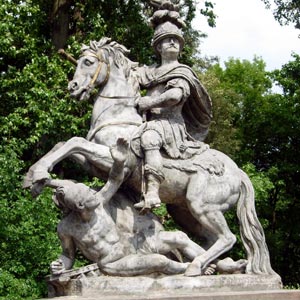
He supported the development of sciences, especially map-making. He hired a personal map-maker. He also started a plan to map all of Poland. But this plan was never finished. At the Royal Castle in Warsaw, he set up an astronomical observatory. He supported astronomers and historical studies. He encouraged books and paintings about famous Polish historical figures.
For his contributions, Stanisław was made a Fellow of the Royal Society in 1766. He was the first royal Fellow who was not British royalty. He also became a fellow of the Saint Petersburg Academy of Sciences in 1778 and the Berlin Academy of Sciences in 1791. He also supported industry and manufacturing. He invested in making cannons and firearms and in mining.
Stanisław himself wrote several works. These included his memoirs, political writings, and speeches from Parliament. He was known as a great speaker and conversationalist.
Different Views of His Reign
King Stanisław August is still a debated figure in history. When he became king, some saw him as just a tool to remove the old rulers. But, as historian Norman Davies noted, "he turned out to be an ardent patriot, and a convinced reformer." Still, many felt his reforms were not enough. He was accused of being too careful, even indecisive. He admitted this fault himself.
His choice to rely on Russia has often been criticized. Stanisław saw Russia as the "lesser evil." He thought Russia would support a weak Poland's independence within its control. However, Russia ended up dividing Poland instead of supporting its reforms. Others accused him of weakness and even betrayal, especially after the Second Partition of Poland. During the Kościuszko Uprising, there were rumors that some Polish revolutionaries planned to kill him.
Another criticism was about his money management. Stanisław actually had little personal wealth. Most of his money came from royal lands. His generous support of the arts and sciences cost a lot of money. He also supported many public projects. He tried to use the royal treasury to cover state expenses when taxes were not enough. Parliament promised to repay him many times, but rarely did. Still, critics often called him a spendthrift.
Historian Andrzej Zahorski wrote a book about Stanisław August. He noted that discussions about Stanisław are affected by the fact that he was the last King of Poland. He was the king who failed to save the country. This failure made him an easy target for blame. Zahorski argues that Stanisław made a mistake by joining the Targowica Confederation. He wanted to keep Poland whole, but it was too late. This choice greatly damaged his reputation for centuries.
How He is Remembered
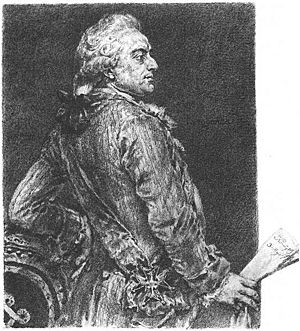
Stanisław Poniatowski has been the subject of many biographies and artworks. Voltaire saw him as a model reformer. He based his character, King Teucer, in the play Les Lois de Minos (1772) on Stanisław. At least 58 poems were written to honor him. He is a main character in many novels and plays.
On screen, he was played by Wieńczysław Gliński in the 1976 film 3 Maja. He also appears in a Russian TV series.
Stanisław Poniatowski is shown in many portraits, medals, and coins. He is prominent in Jan Matejko's paintings. These include the 1891 painting, Constitution of 3 May 1791, and Rejtan. A statue of Stanisław Poniatowski was put up in Łazienki Palace in 1992. Many cities in Poland have streets named after him, including Kraków and Warsaw.
Family Life
Stanisław Poniatowski never married. When he was young, he loved his cousin Elżbieta Czartoryska. But her father did not approve because he thought Stanisław was not rich or powerful enough. By the time Stanisław became king, Elżbieta was already married.
His agreement when he became king said he should marry a Polish noblewoman. But he always hoped to marry into a royal family. When Catherine II made it clear she would not marry him, there were hopes of marrying an Austrian archduchess. A marriage to Princess Sophia Albertina of Sweden was also suggested. But his sisters opposed this, and it did not happen. His favorite niece, Urszula Zamoyska, took on the role of queen and hostess at his court.
Some historians believe he secretly married Elżbieta Szydłowska later. However, a person who knew them both said this rumor only spread after Stanisław's death. Most people did not believe it.
He had children with two women. With Magdalena Agnieszka Sapieżyna, he had Konstancja Żwanowa (1768–1810) and Michał Cichocki (1770–1828). With Elżbieta Szydłowska, he had Stanisław Konopnicy-Grabowski (1780–1845), Michał Grabowski (1773–1812), Kazimierz Grabowski (1770-?), Konstancja Grabowska, and Izabela Grabowska (1776–1858).
Images for kids
See also
 In Spanish: Estanislao II Poniatowski para niños
In Spanish: Estanislao II Poniatowski para niños


